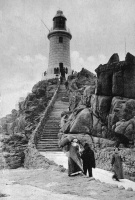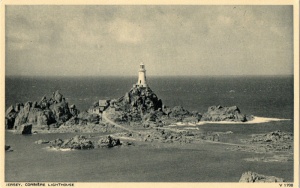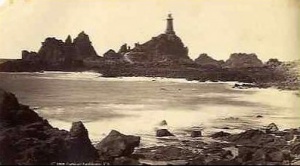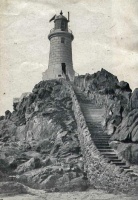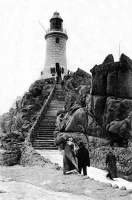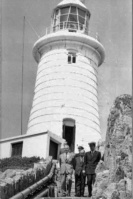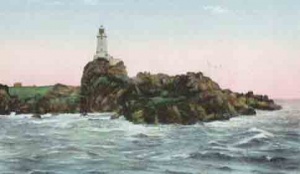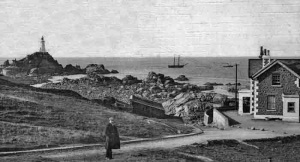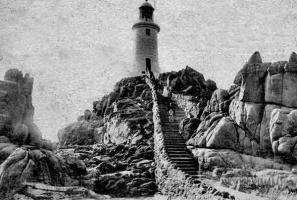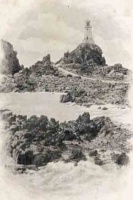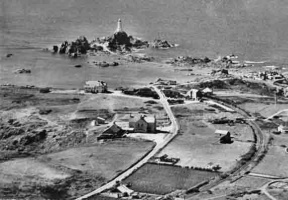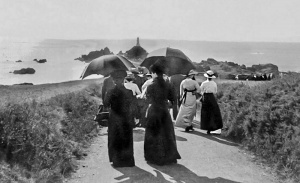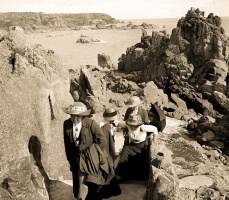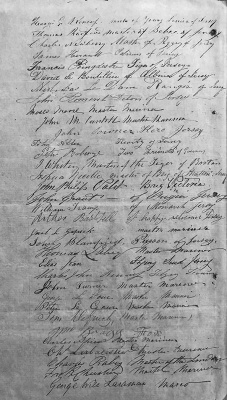On the coast
|
|
La Corbière
An Ouless etching of Corbière Lighthouse on its completion in 1873 La Corbière, known to islanders simply as Corbiere, is on the south-west corner of Jersey, where a lighthouse has been protecting shipping from grounding on the rocky coastline for nearly 150 years Click on Pegman to view the location in Google Street View
|

Violent seas have caused many a shipwreck at Corbiere over the years. The name, which is probably derived from corbeau, the French for crow, is commonly found elsewhere in the French-speaking world, notably in Guernsey, the north Brittany coast, central France and Switzerland.
Jersey's Corbière is first recorded in the 1309 Assize Roll, when the issue arose of a tub being washed ashore there, and it was a regular occurrence for a ship to founder on the rocks when rounding the corner of the Jersey coastline in stormy weather and its cargo to be washed up on the sands of St Ouen's Bay.
It was not until 1873 that the lighthouse was constructed which now allows ships to plot a safe route. It is 11 metres tall and was the first lighthouse in the British Isles to be constructed of concrete. [1]
The light can be seen from a distance of over 25 kilometres, but this has not stopped smaller vessels from taking a short cut through the rocks off the coastline en route from Jersey to Guernsey and coming to grief after striking a hidden rock.
Victor Hugo
Victor Hugo described the area as the 'herdsman of the waves' and in years gone by mariners knew it as the 'dreaded Corbiere'.
Light
The lighthouse is now automatic, but it was previously manned on a rota basis by four keepers, who lived in cottages nearby and worked a two-day shift. They were also required to signal to St Helier when approaching ships came into view.
Balleine
From The Bailiwick of Jersey by George Balleine
- "We are told that the word comes from corbeau, a crow, rook, or raven and, if we ask why our forefathers specially noted the haunts of crows, the most probably answer is that the crow was considcred a bird of ill omen. Certainly Jersey's Corbiere has proved a death-trap to many a ship.
- "The Chroniques tell how in 1414 "a great Spanish ship was lost on the Corbiere, and the sands of St Ouen Bay were strewn with casks of wine", and the hall of the manor, for the seigneur had the right to all wreckage, could hardly contain the puncheons that were stored there.
- "On St Catherine's Day, 1495, five Spanish caravels were driven on these rocks, and the sand-storm which destroyed the fertility of Les Quennevais was attributed by tradition to God's wrath at the cruelty shown to their crews, And so the dismal tale went on throughout the ages. At last, in 1873, a lighthouse was built by the States. Imrie Bell, the engineer, chose an isolated rock 500 yards from the shore. On this he placed a concrete platform 9 feet high, and a tower 35 feet high on the top of that, the first lighthouse in the British Isles to be built of concrete. The light, which is now electric, can be seen for 18 miles.
- "The rush of the tide round these rocks is extremely dangerous. At the entrance to the causeway is a memorial stone to 'Peter Edwin Larbalestier, assistant keeper at the lighthouse, who on 28 May 1946 gave his life in attempting to rescue a visitor cut off by the incoming tide. Take heed, all ye that pass by!'
- "The headland is studded with concrete fortifications that the Germans left behind. Near their tall fire-control tower is a tiny cove known as La Rosiere (tbie may mean a place where reeds grow, from the old French ros a reed, or it may refer to wild roses, of a creeping variety, which grow in the vicinity). There are caves there which, it is firmly believed, used to be used by smugglers.
- "It was here that, in September 1859, the mail steamer Express was wrecked, with some loss oflife. A large area of headland has been generously given to the Island by the Le Quesne family, to be preserved for ever as an open space. A deep quarry, long derelict, is to be used to house a sea-water desalination plant, but it is hoped that this project will be discreetly planned, and not interfere with such a splendid open, unspoilt area.
- "The other object of interest on this wind-swept point is the Table des Marthes (the table on which children played marthes, ie knucklebones). It lies at the spot where in railway days the Corbiere station stood. This great block of red granite, 12 feet long, 6 feet wide, and 2 feet thick, is undoubtedly the capstone ofa prehistoric tomb. As late as 100 years ago contracts signed on this table were regarded as especially binding.:
Account of the lighthouse's construction
- Construction of Corbiere lighthouse, A detailed discussion paper on the construction of the first concrete lighthouse in the British Isles, by Imrie Bell
Histories
- Corbière and Petit Port, a Jersey Archive history Added 2016
- Corbière and the Vingtaine of La Moye in census returns Added 2016
- Coast: Corbiere, one of the stops on our coastal tour of Jersey Added 2019
Notes and references
- ↑ Although there was a strong demand from mariners and shipping companies for the construction of a lighthouse, they did not want to help finance its construction and ongoing maintenance. On 26 March 1872 the manager of the Weymouth and Channel Island Steam Packet Company, Mr John Wimble complained to the States regarding a levy for the new lighthouse. A Levy of 1d per ton on shipping for the maintenance of the lighthouse has been proposed. Mr Wimble said that two-thirds of this would be contributed by the steamers, which already paid high harbour dues. He claimed that a lighthouse would benefit sailing vessels, but not steamers. Although the London and South Western Railway Company fundamentally agreed with Mr Wimble's complaint, they did not at this stage commit to a formal objection.

A photograph by Philip Morel-Laurens
A photograph by Philip Morel-Laurens
1865 petition and States decision
A petition to the States in 1865 calling on them to build a lighthouse at La Corbiere







